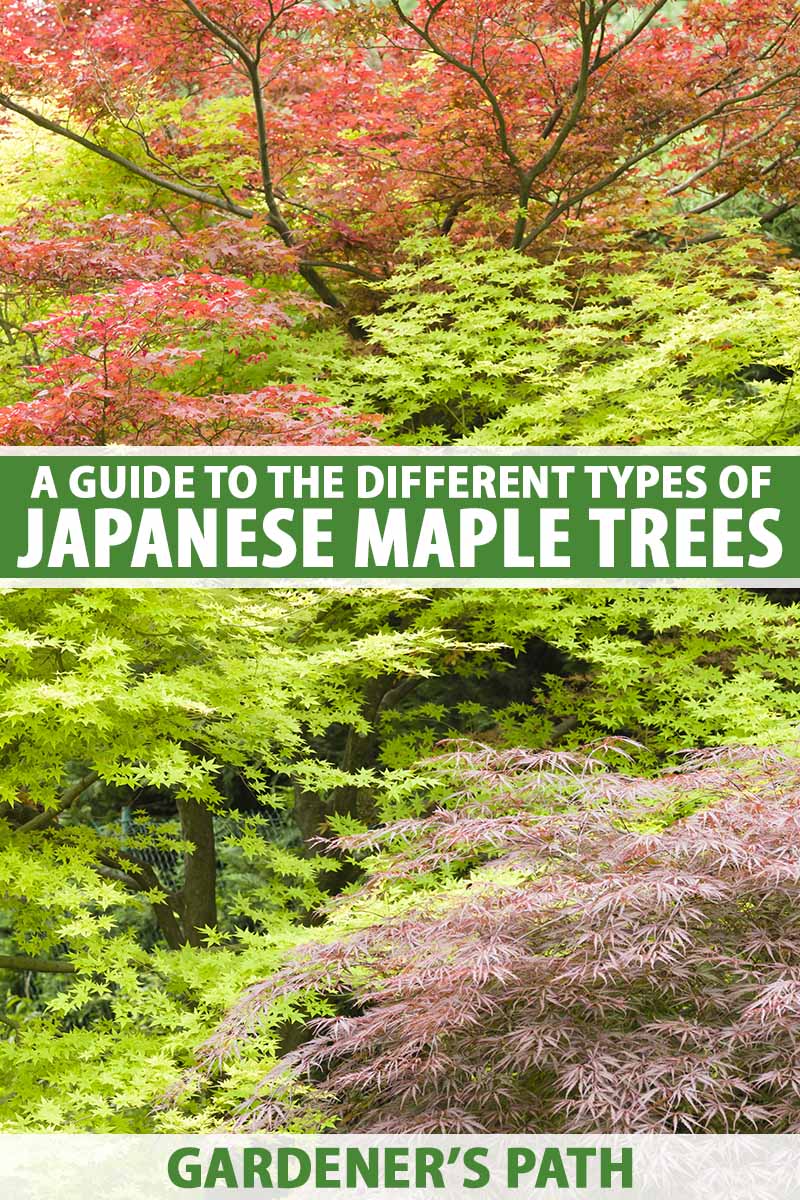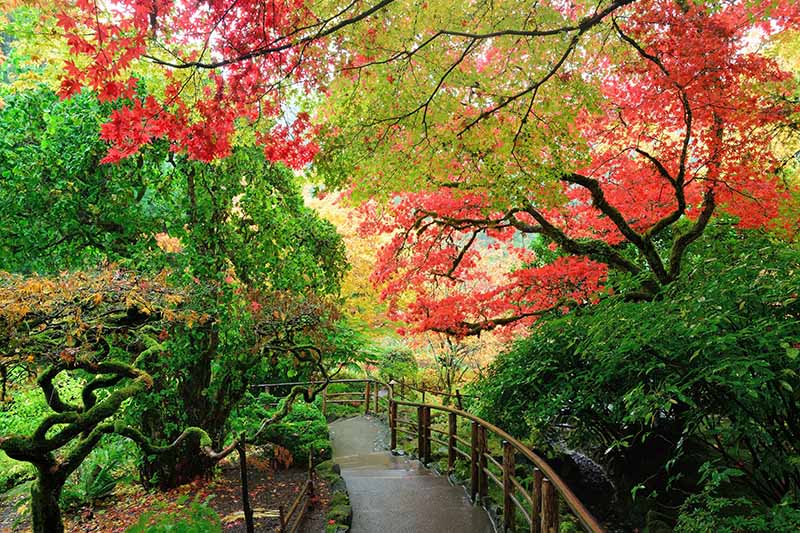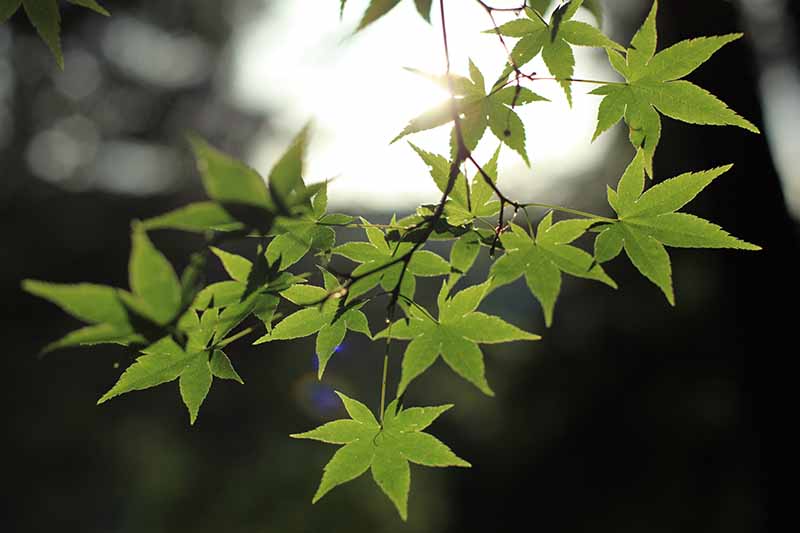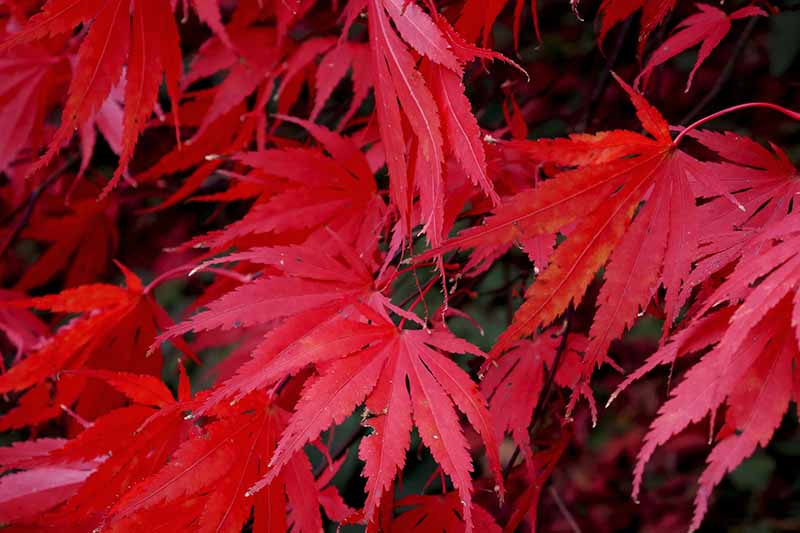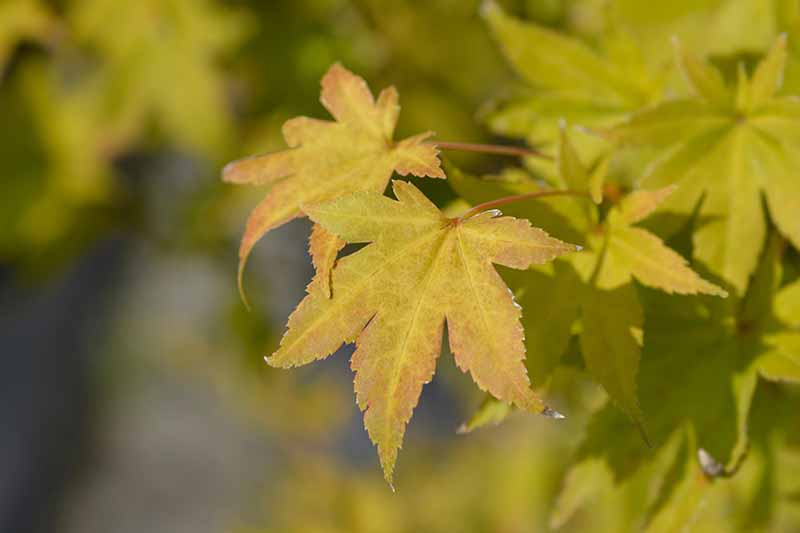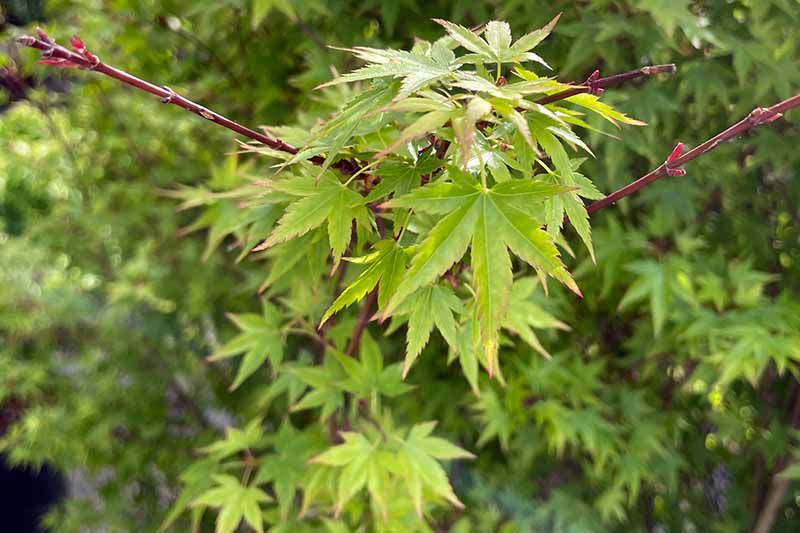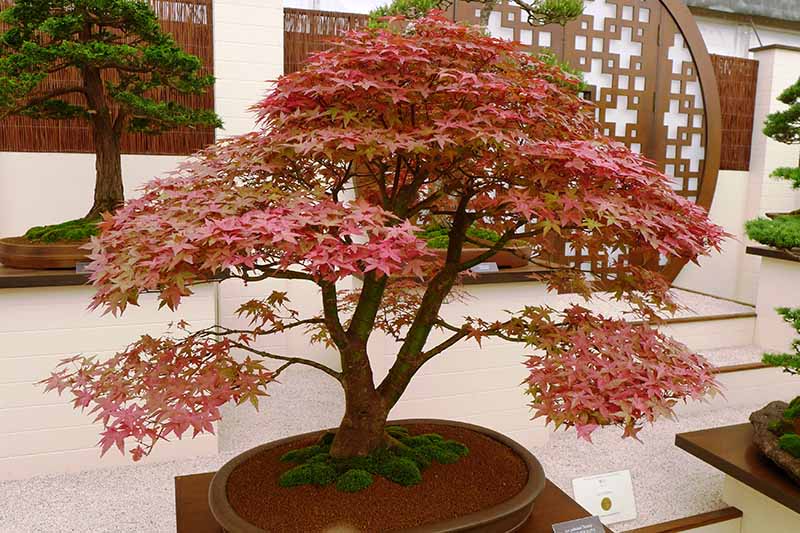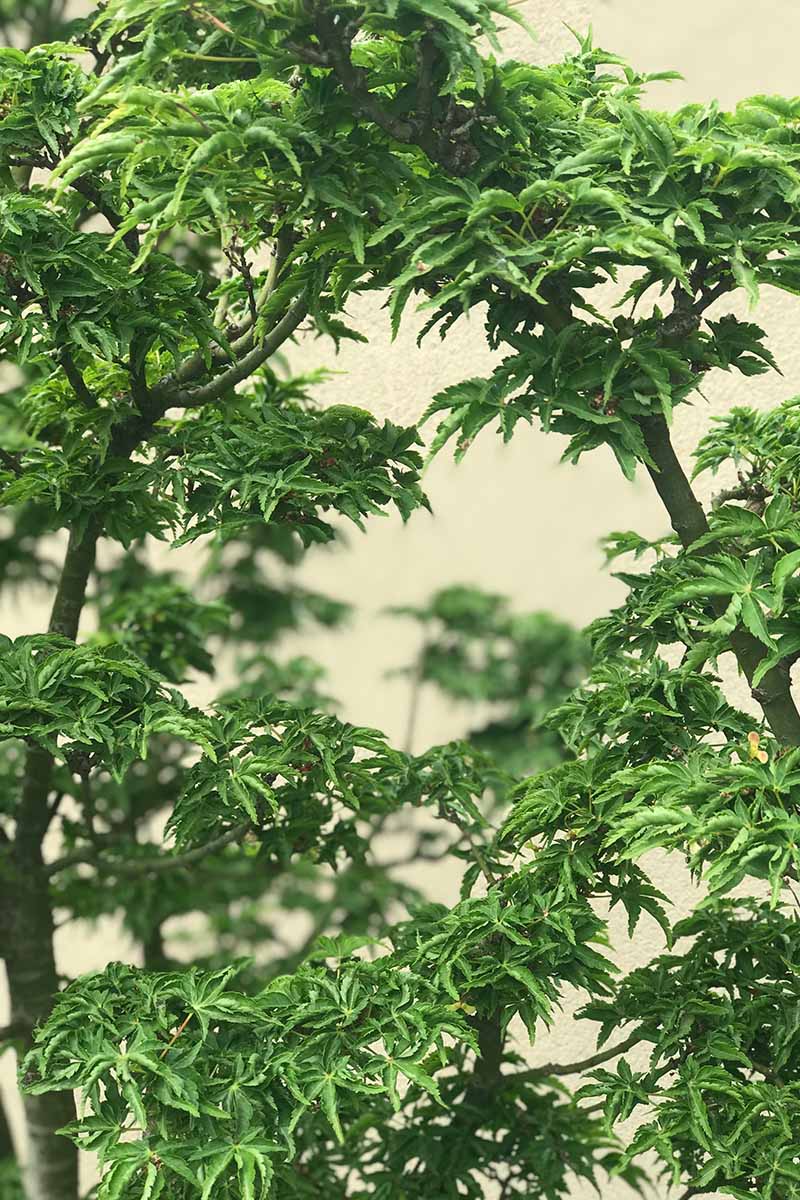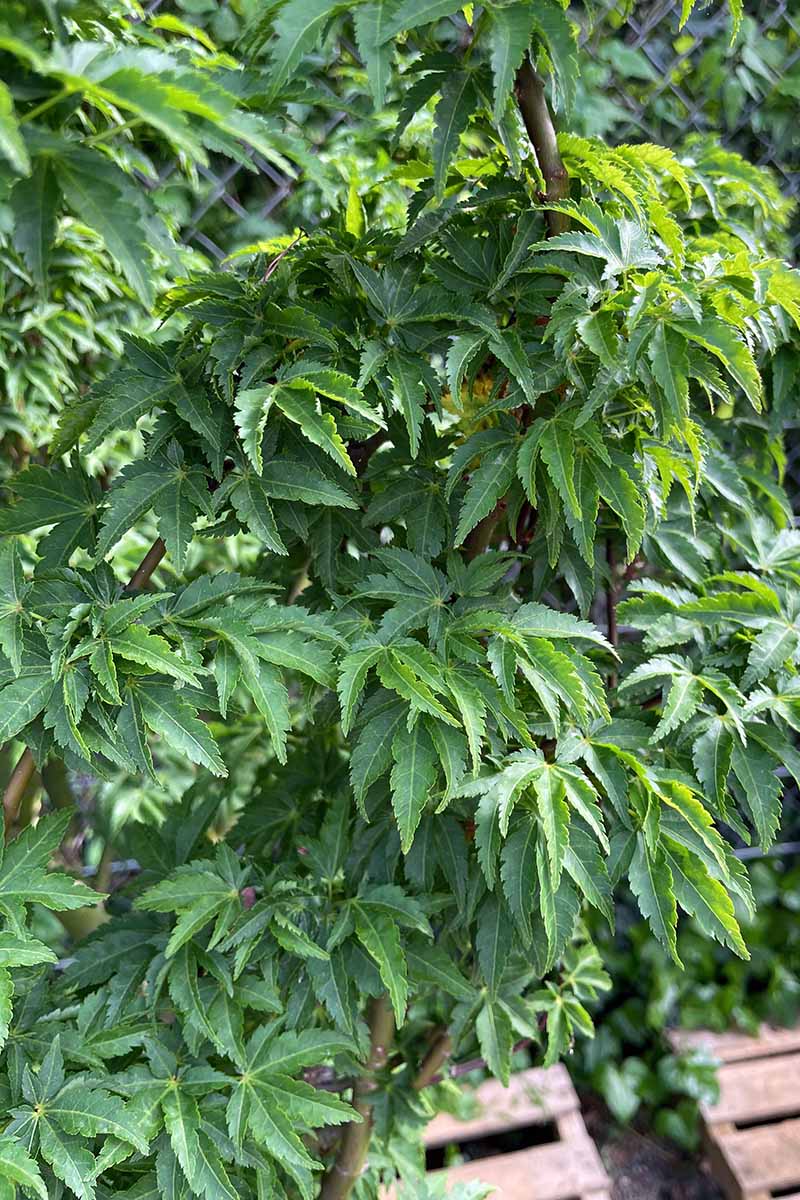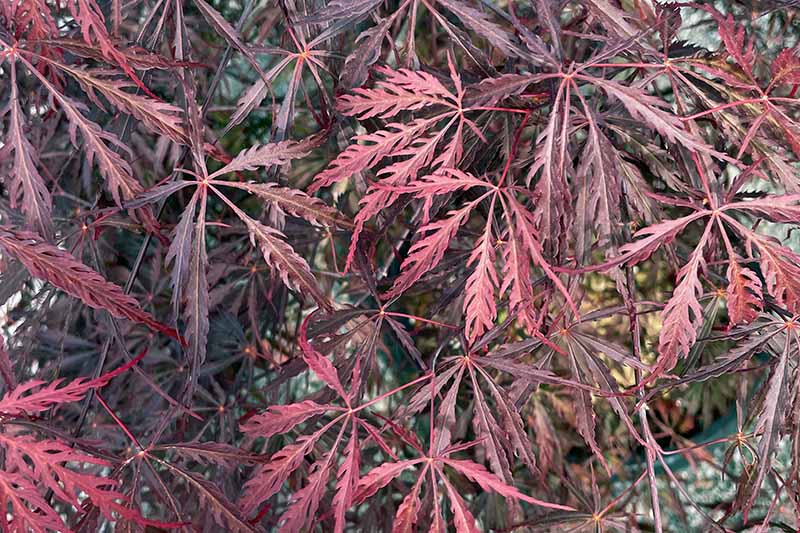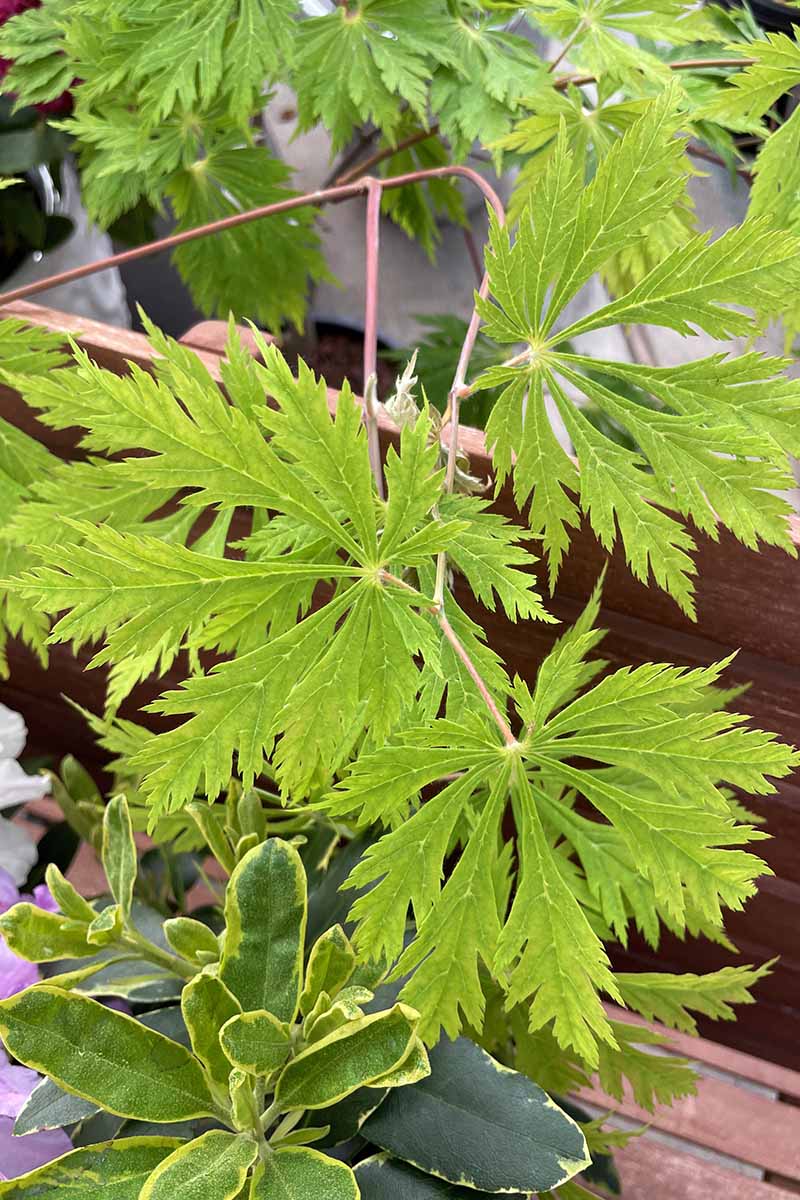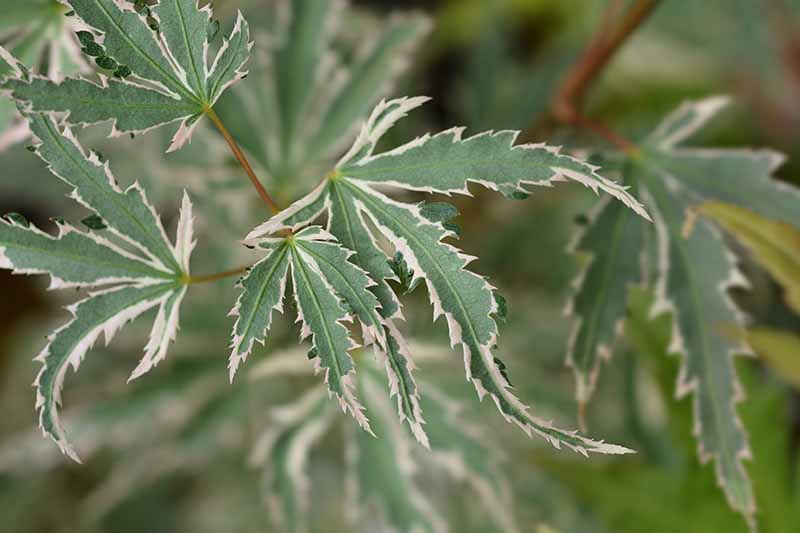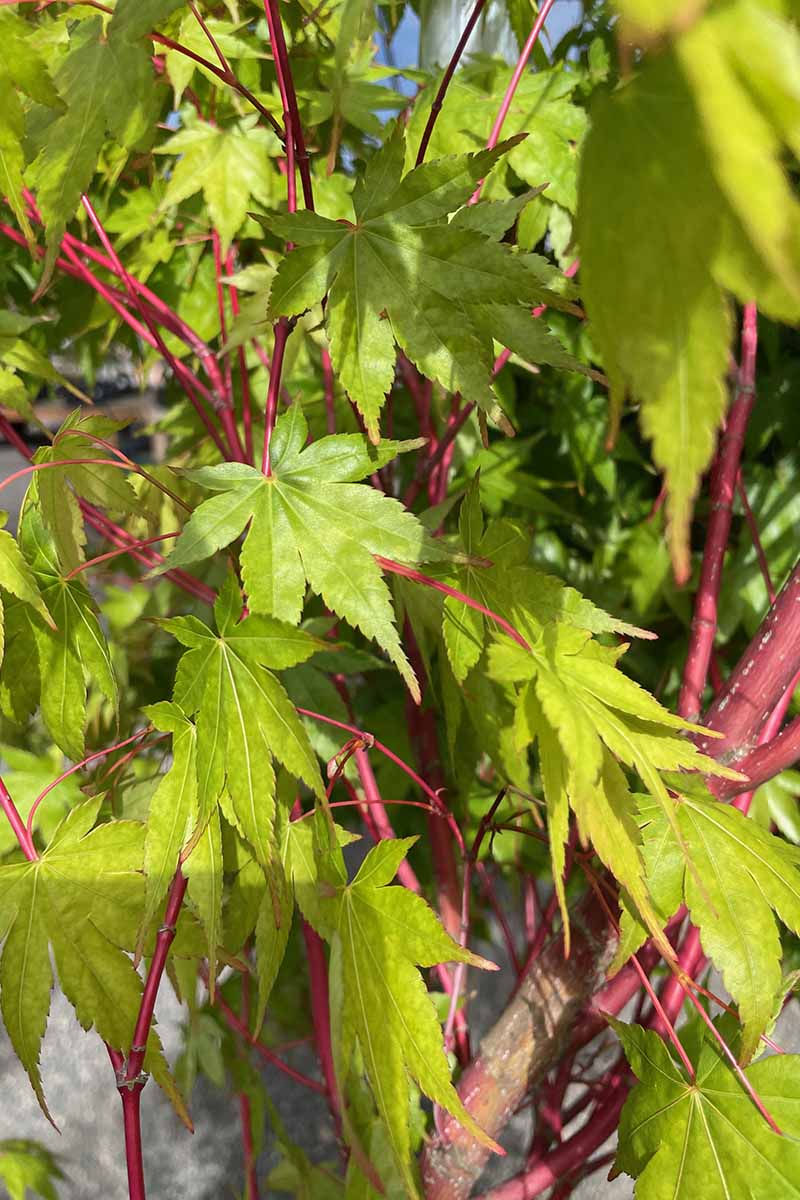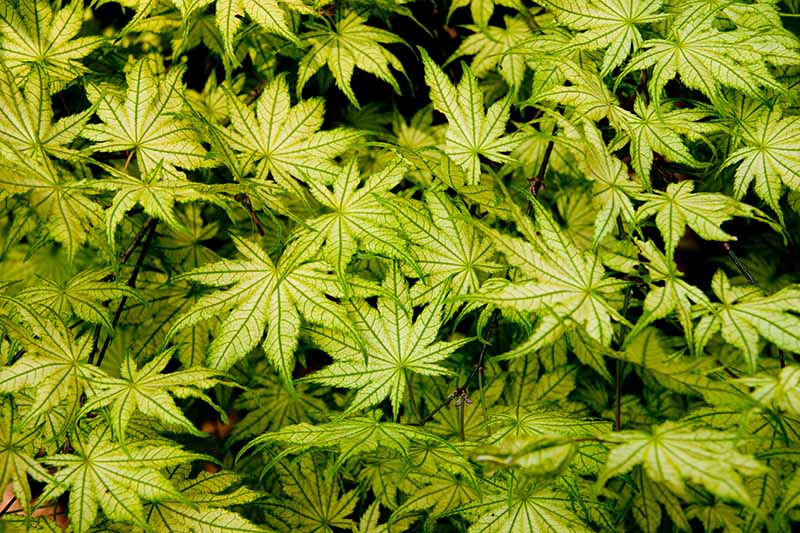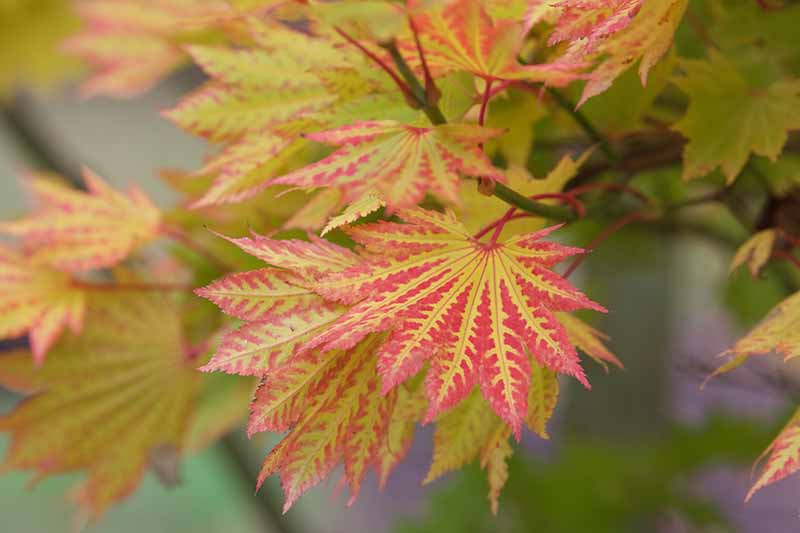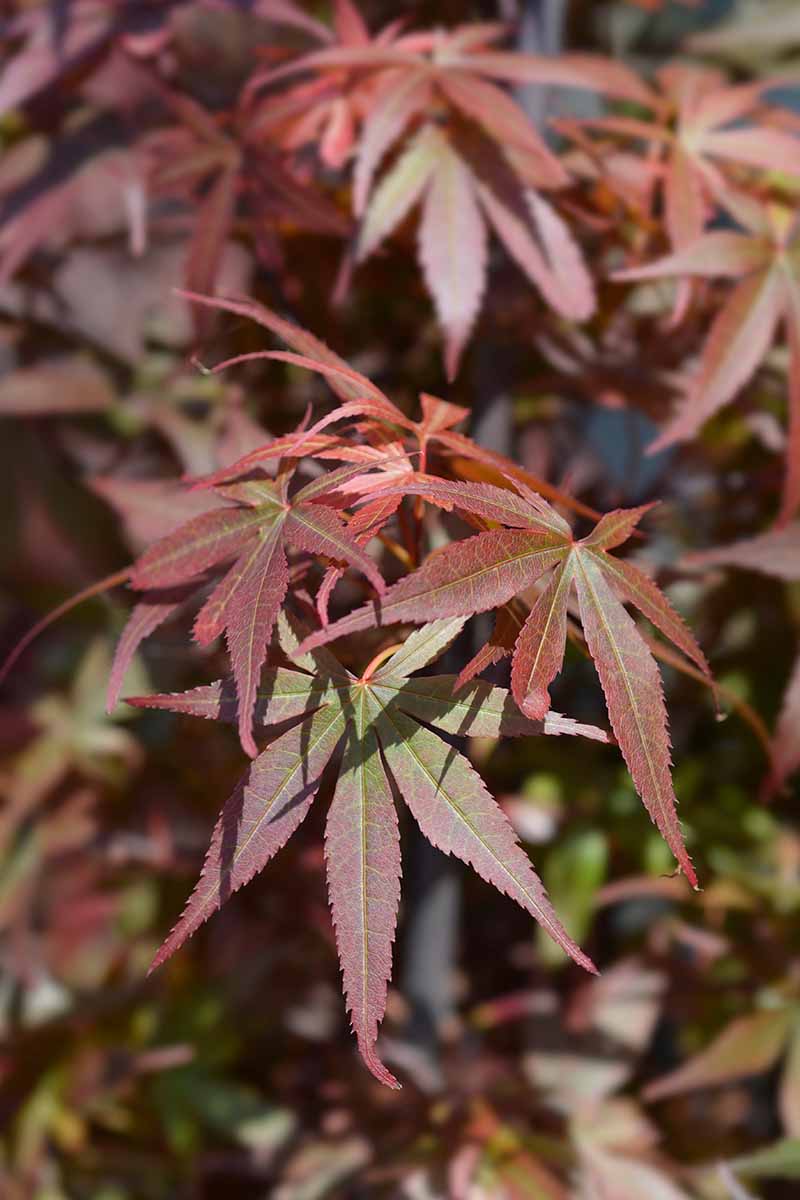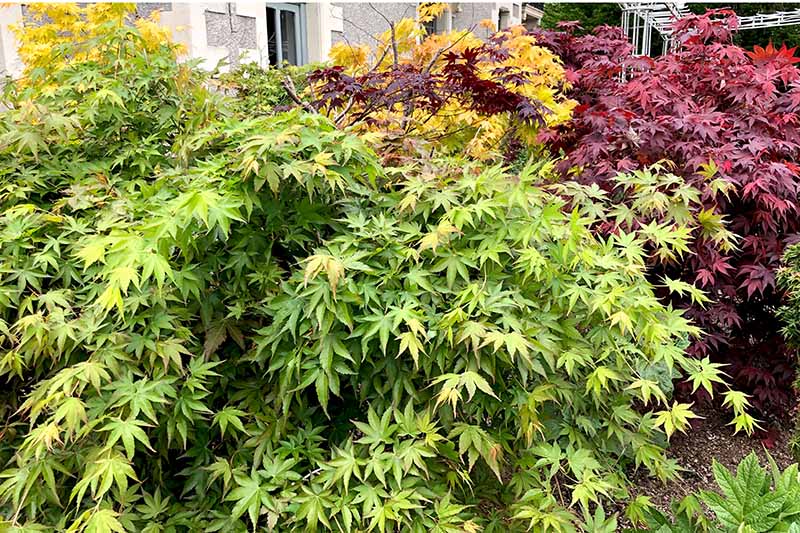While that’s wonderful in terms of options, it can be a challenge when you’re trying to talk all things Japanese maple: “You know, the one with the really deeply divided lobes? Not, not that one. The one with the super serrated edges? No…” Some enthusiasts simply divide maple trees into two groups: upright and weeping. But if you want to truly understand this diverse and ever-evolving group of plants, you need to be able to describe them more specifically. We link to vendors to help you find relevant products. If you buy from one of our links, we may earn a commission. That’s why experts on these plants created 17 categories to define all of the different types of Japanese maples that are out there. In our guide to growing Japanese maples, we cover how to cultivate these trees in your landscape. If you assumed that the main difference between Japanese maples was growth habit and size, you’re in for a real treat! Let’s get started.
How Japanese Maples Are Categorized
If you’ve ever shopped for Japanese maples, you might not realize that many of them are mislabeled. But I’ve taken a gander at the available varieties at several places that shall remain nameless and found that they had multiple trees that were labeled completely wrong! I felt bad for the customers who thought they were bringing home a tree that was labeled as a type having red foliage, only to discover after they planted it that the foliage turns green in the summer. Clearly, there was a gap in the Japanese maple world that led to some labeling confusion. Enter the Maple Society. Using their system, you’d know if you were looking at a correctly labeled atropurpureum that it would stay red all summer long. The Maple Society is a United Kingdom-based group that registers new cultivars in the Acer genus, and taps into the expertise of botanists and Japanese maple experts around the world. They have officially broken up the broad category of Japanese maples into 17 groups, using the system defined by noted expert Cor van Gelderen, and building on the work of nurseryman Benoit Choeau. This system is particularly helpful because these plants may come from one of numerous Acer species that are indigenous to Japan. A. palmatum is the most common, but you’ll also see the species A. shirasawanum, A. japonicum, A. capilipes, and more, along with their hybrids. Originally, J.D. Vertrees, a highly respected entomologist, grower, and educator based in Oregon who is generally thought of as one of the most knowledgeable Japanese maple experts in the West, grouped the plants into seven categories. Five of his categories are used by the Maple Society today, plus twelve more. The five categories that overlap between Vertrees’ and the Maple Society’s are: amoenum, dissectum, linearilobum, matsumurae, and palmatum. Vertrees also grouped all dwarf plants together, and had a final category called “other” for everything else. Both classification systems are generally based on the division of the leaf lobes, variegation, and color. Before we jump in, we need a quick leaf anatomy lesson so we are all on the same page with these terms:
Lobes on a leaf are projections that extend from a central point, like fingers.A sinus is the gap between the lobes.A petiole is the little stem that attaches the leaf to the branch of the tree.The margin is the outside edge of the leaf, and the veins extend from the petiole up through the leaf to transport water.
Now, let’s take a look at each of the 17 classifications used to describe Japanese maples today.
Amoenum
This group is a good one to start with, because it includes basically any plant that doesn’t have distinct characteristics that put it in another category. What they all have in common is that the leaves aren’t deeply lobed, and the foliage is green in the summer. Beyond that, this group is related in that they all have leaves with seven distinct lobes. Check out ‘Ōsakazuki’ for a good example of this variety. The bright green leaves have seven deep lobes and the margins of the leaves are deeply toothed. In the fall, the foliage turns bright scarlet. Once mature, the tree is about 15 feet tall and wide. Defining characteristics: Leaves are only lobed to half the blade or less, summer foliage color is green. Each leaf has seven lobes.
Atropurpureum
This category contains some of the most popular and recognizable Japanese maples. Basically, if a tree is upright with red foliage and it doesn’t fit under witches’-broom or linearilobum, you’ll find it here.
Aureum
Trees in the aureum category stand out because of the color of their foliage. The leaves are bright yellow or orange in the spring before turning yellow or lime green during the summer. They then fade to a pale chartreuse in the fall. The foliage is deep, dark red and the leaves are deeply lobed with five “fingers.” ‘Bloodgood’ By the way, if you want to bring home a ‘Bloodgood,’ Nature Hills Nursery carries them in quart-sized containers. Defining characteristic: Summer foliage color is red or purple. ‘Golden Moon’ is an extremely popular option. It has foliage with seven or nine sharply pointed lobes, and grows to about 20 feet tall and wide. ‘Summer Gold’ stays under ten feet tall, and features leaves with seven or nine medium lobes. ‘Autumn Moon’ emerges in the spring with lime green leaves with a hint of orange before transitioning to burnt orange in the late summer. In the autumn, the color becomes bright orange. The tree grows to about 18 feet tall and 15 feet wide when mature. Defining characteristic: Summer foliage is yellow or orange.
Convexum
What makes this group unique is that the lobes of the leaves are convex, and many of them are deeply lobed. ‘Trompenburg’ is a perfect example. It has deeply lobed, dark maroon leaves, the lobes of which bend back from the midrib or veins. It stays under 20 feet tall. Defining characteristic: Convex lobes.
Corallinum
This group features trees that never fail to draw attention with their bright pink foliage in the spring, before transitioning to bright red and then dark red with hints of green, or entirely green, in the summer. A good example is ‘Deshōjō.’ It has striking bright pink leaves with green centers in the spring before turning bright red and then fading to green. The leaves have five or seven lobes. ‘Amber Ghost’ is another corallinum beauty, starting out bright pink and then fading to more of a melon color. In the summer, it turns green with some pink and red at the tips of the leaves. In fall, the foliage changes again, becoming bright red and orange. It grows to about 15 feet tall and wide. Enthusiasts in Japan call these plants “spring trees,” because that’s when the foliage really shines (and when they’re exhibited at bonsai shows). Defining characteristics: Leaves are only lobed to half the blade or less, spring foliage color is pink or pinkish-red.
Crispum
The crispum group features leaves that are wrinkled or crinkled. Most of the trees stay fairly small, but a few grow to around ten feet tall. ‘Shishigashira’ (or ‘Lion’s Head’ in English) has small, crinkled, deeply-lobed green leaves. This tree grows fairly tall for the category, to about 15 feet. ‘Krazy Krinkle’ has deeply lobed, wrinkled leaves with heavily toothed margins. This tree stays under ten feet tall. ‘Mikawa Yatsubusa’ is a dwarf maple that stays under four feet tall, with tightly packed and layered green foliage. Defining characteristic: Wavy or curly leaf margins.
Dissectum
This group is a real stand-out because the foliage looks like lace from far away. Up close, you’ll see that the leaves have long, slender “fingers” that are deeply lobed. In fact, the leaves are so deeply lobed that each division goes back to the base of the leaf, so they look like separate little leaves. The leaves usually have heavily toothed margins, adding to the lace-like effect. Most plants have a weeping growth habit, but not all.
Linearilobum
You could almost mistake the trees in this category for bamboo. That’s because they have extremely narrow, deep lobes that aren’t deeply toothed, as those in the dissectum group are. In the fall, it turns bright, vibrant red. ‘Tamukeyama’ You can’t find a higher recommendation than that, so if you want to purchase one for your space, head to Nature Hills Nursery for a plant in a quart container. ‘Garnet’ stays under eight feet tall with characteristic dissectum leaves in deep maroon that turn bright garnet red in the fall. ‘Crimson Queen’ is another classic favorite. It has deeply toothed and lobed leaves in dark red, and a cascading growth habit. It stays compact, under ten feet tall. ‘Crimson Queen’ Nature Hills carries a “balled and burlapped” five- to six-foot tree that you can add to your landscape. Defining characteristic: Deeply divided lobes with heavily toothed margins. ‘Koto No Ito’ is a typical example. The foliage on this gorgeous tree starts out red, transitions to apple green in the summer, and gradually becomes vibrant golden yellow in the fall. It has a narrow, upright growth habit and tops out at ten feet. Vertrees called out ‘Red Pygmy’ as one of his favorites from this group. This weeping tree grows to just six feet tall and wide, with red spring foliage that transitions to olive green in the summer. When autumn arrives, the leaves become golden orange. Defining characteristic: Deeply divided lobes with lightly toothed or smooth margins.
Matsumurae
The trees in this group have leaves with seven to nine lobed leaves, with sinuses that go all the way down to the base. But instead of having long, thin lobes like linearilobum or dissectum, the lobes are more rounded. The margins are finely serrated. Vertrees points to ‘Omurayama,’ as a nice example of this category. This variety is a 15-foot-tall tree with a cascading form. The foliage starts out light green with hints of orange before turning green in the summer. In the fall, the leaves turn red, orange, and yellow. Often you’ll see this type of Japanese maple called “fern leaf.” Defining characteristic: Deeply divided lobes with wide sinuses, toothed margins, green summer color.
Marginatum
This group is made up of plants with variegated foliage. What sets this grouping apart from variegatum, which also features trees with variegated foliage, is that the leaves have an extremely distinct contrast between the coloring on the margin and the center of the leaf. To see a good example of this particular group, check out ‘Butterfly.’ The foliage on this tree has creamy white margins and a grayish-green center. In the spring, the margins might have some pink hues to them, and in the fall, the margins turn red. The leaves have five lobes and the tree grows to be about 12 feet tall when mature. ‘Yama Nishiki,’ known as ‘Snow Peak’ in the West, has a distinct variegation with creamy white on the margins and medium green centers. Young leaves look slightly mottled before they form a stark contrast. While most variegated Japanese maples are green, ‘Shirazz’ is primarily red. In the spring, the leaves are dark red with light pink margins, before turning slightly greenish-red in the center with pink margins. This cultivar grows up to 15 feet tall. Defining characteristic: Leaf margin contrasts with center.
Palmatum
This group can be a little confusing, since the most common species of Japanese maples is A. palmatum. But in this case, this grouping can include other species as well. The word “palmatum” is Latin for hand, and that’s what defines this group. All of the leaves in this group resemble hands in that they have five lobes (and rarely seven), and the sinus extends no further than one-third down the length of the leaf. Any plant that doesn’t have a secondary characteristic that would make it more suitable for a different grouping, such as red wood, is placed in this category. ‘Diana’ is a good example. This tree stays compact at under three feet. It has green foliage with a pink and white margin. Defining characteristics: Leaf lobes extend no more than one-third the length of the leaf, with brown or green wood in the winter.
Pinebark
The name of this group says it all. Instead of having the typical smooth bark that most Japanese maples have, the bark on these trees is rough and looks a bit like – you guessed it – pine bark. The foliage in this group is incredibly varied, since only the bark is used to categorize these plants. Most start out with smooth bark when they are young before developing the characteristically rough bark. Check out ‘Nishiki Gawa,’ and ‘Arakawa’ to see what this bark looks like. Defining characteristic: Pine-like, rough bark.
Red Wood
As with pinebark trees, this group is entirely defined by its bark. All of the trees in this group have bright red, coral, yellow, or orange branches.
Reticulatum
Trees in this group are defined as having leaves with veins that are a different color than the rest of the leaf. Also known as reticulated maples, this group has some real stand-outs. ‘Sango-kaku’ is the one you’ll most commonly see. ‘Sango-kaku’ It has bright coral bark that contrasts with the lime green leaves. Nature Hills Nursery carries this striking tree in #2 containers. Defining characteristic: Bark is coral, orange, yellow, or red in winter. For instance, ‘Nathan’ has orangish-red foliage with green veins. ‘Aka-shigitatsu-sawa’ starts out with pale pink leaves with green veins, before transitioning to green and red leaves with green veins. ‘First Ghost’ has creamy white or pale green leaves with deep green veins. Defining characteristic: Leaf veins contrast with the rest of the leaf.
Sessilifolium
The plants in this group are defined by their lack of petioles. Sessile is a botanical term indicating the lack of a stalk. Instead, the lobes of each leaf have a sort of petiole-like structure that attaches them to the stem. It doesn’t matter if the tree has variegated foliage or any other particular characteristic. If it lacks petioles, it’s a sessilifolium, also known as stalk-less maple. Most of these trees are a bit more difficult to find, but there are a few that are gaining in popularity. ‘Beni-hagaromo’ has red foliage that turns purplish-brown in the summer. Thanks to its heavily toothed margins and typical sessilifolium lobe attachment, the tree looks like it is covered in colorful feathers rather than leaves. Defining characteristic: Sessile leaves.
Variegatum
Variegated maples either fit into this group or the marginatum group. To call ‘Ukigumo’ a variegated plant doesn’t do it justice, though. This A. palmatum cultivar, also known as ‘Floating Clouds,’ looks almost ghostly white, with pale whitish-pink foliage that fades gradually to green in the center of each leaf. But the center is more of a pink and white color with spots of deep green, rather than a solid green. The warmer the climate, the less variegation you’ll see, but in cooler climates, it’s quite striking. Unlike some Japanese maples, which tend to revert at the slightest provocation, this one tends to stay true. ‘Kumoi Nishiki,’ also known as Siebold’s maple, (A. sieboldianum) has beautifully dappled leaves that feature a blend of creamy white and apple green. This plant stays under 10 feet tall. ‘Peaches and Cream’ stands out because the leaves are creamy white and rose pink in the spring, transitioning to green and white with dark green veins and rose pink margins in the summer. This one stays under 10 feet tall. Defining characteristic: Leaf is variegated beyond just the margins.
Witches’-Broom
While most Japanese maple leaves look like hands with a longer middle lobe, the central lobe on witches’-broom trees is short and stumpy, kind of like a hand with the middle finger cut off below the middle knuckle. ‘Carlis Corner Broom’ has bright pink leaves in the spring that shift to dark burgundy in the summer. By fall, the foliage is dark red. ‘Skeeter’s Broom’ has bright red foliage that turns bronze in the fall. ‘Vic’s Broom’ is a dwarf plant that tops out at four feet, but that doesn’t mean its impact in the garden is small. The small, pale green leaves are bordered with rose red margins. In the fall, the foliage turns bright yellow with bits of orange and red. Defining characteristic: Middle lobe is short and usually shorter than surrounding lobes. And with growers working hard to create new types of trees, there are sure to be even more interesting options coming down the line. That’s why it’s so handy having them grouped into these easy-to-understand categories. Now, the next time you head to the nursery, you can tell them that you’re looking for the perfect “red bark” to add some winter color to your yard. If you’re like me, no doubt it’s impossible to pick a favorite, but let us know what type you’re hoping to get your hands on (or already have). Did this guide help you make sense of the wild and wonderful world of Japanese maples? Let us know in the comments section below! And if you have trouble choosing, be sure to check out some of our favorites in our supplemental guide, “21 of the Best Japanese Maple Varieties.” And we have some other great guides to Japanese maple care for you to check out next, starting with these:
How to Propagate Japanese Maples from SeedHow and When to Fertilize Japanese Maple Trees13 of the Best Companion Plants for Japanese Maple Trees
